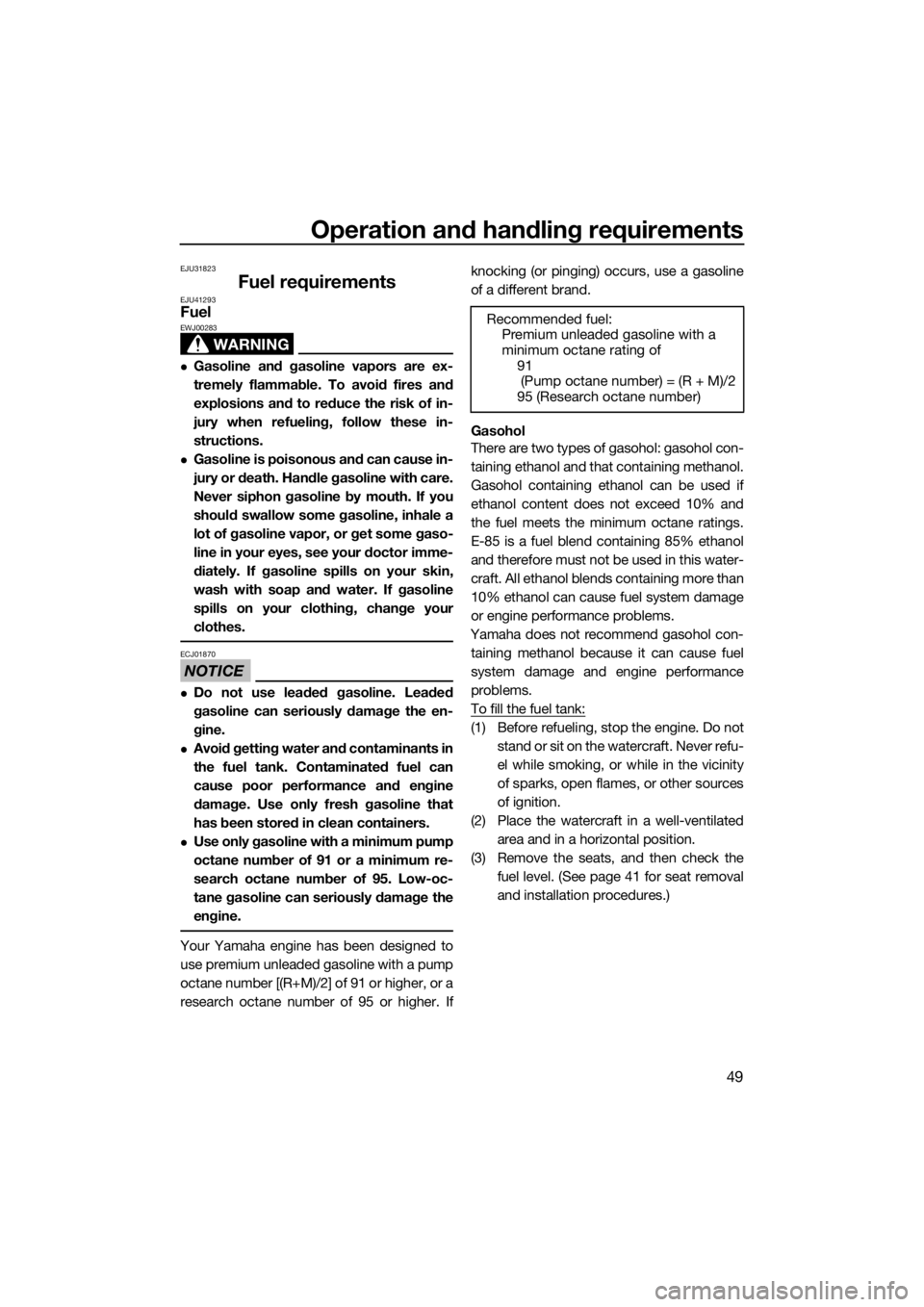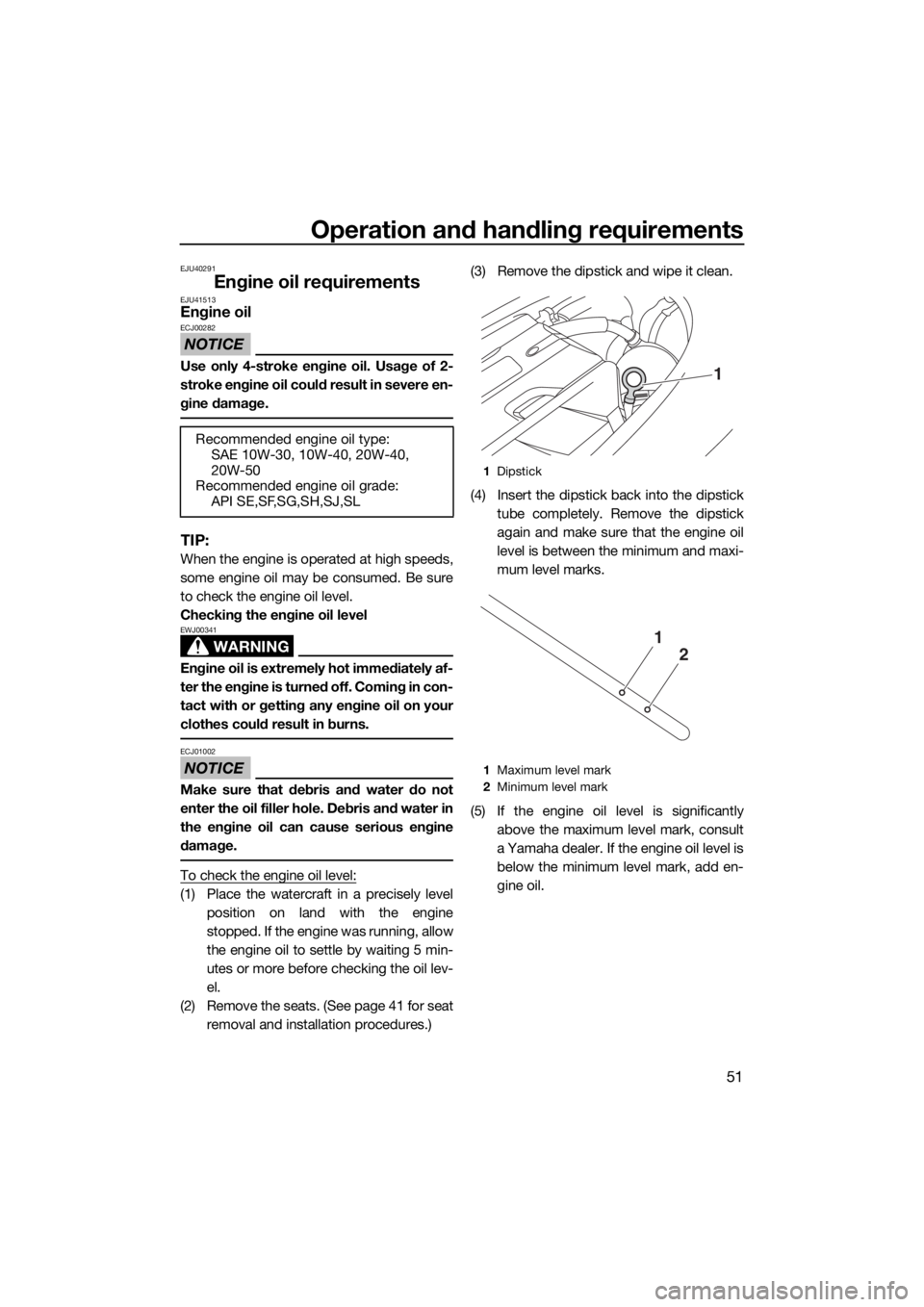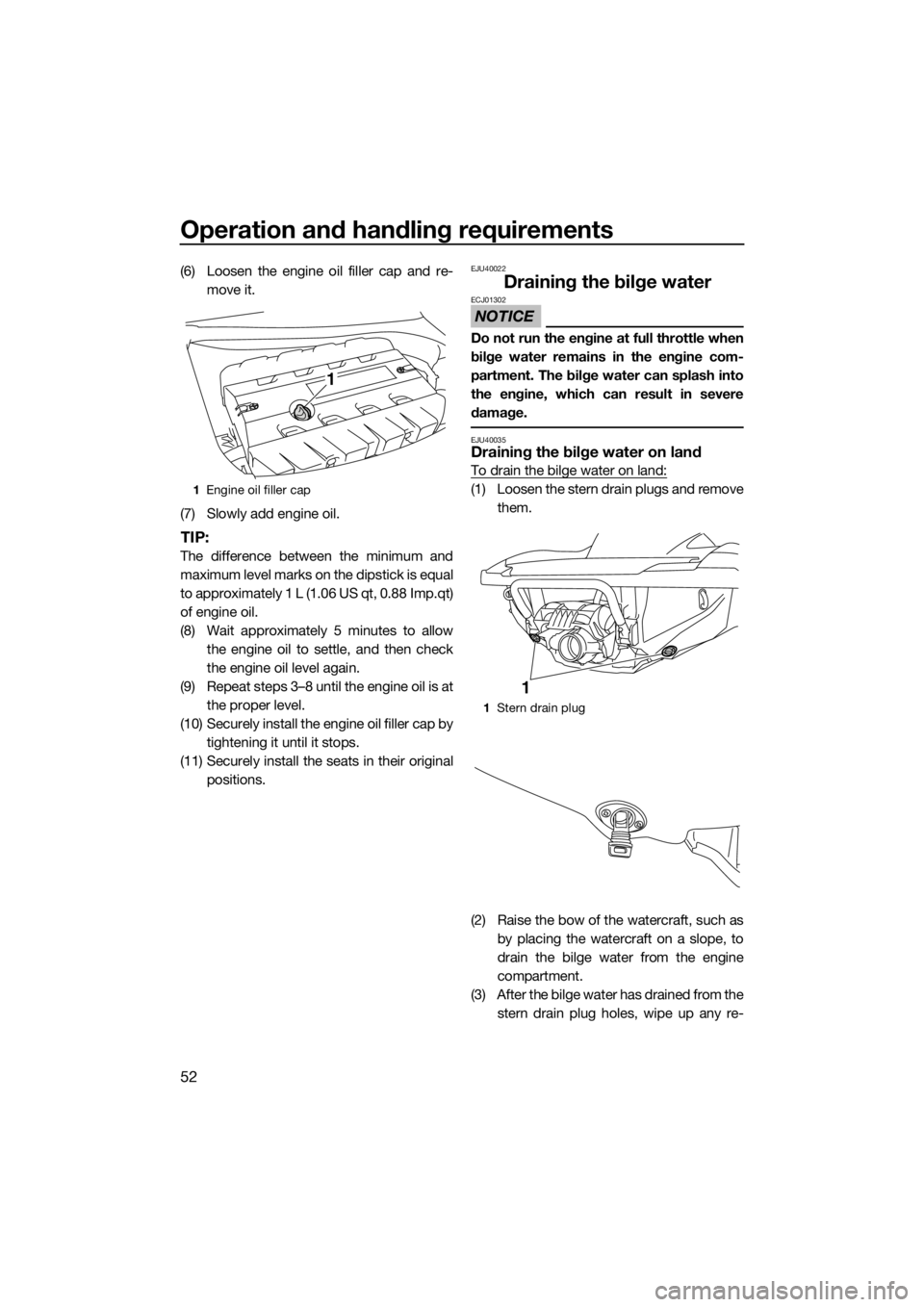YAMAHA FZS 2015 Workshop Manual
Manufacturer: YAMAHA, Model Year: 2015, Model line: FZS, Model: YAMAHA FZS 2015Pages: 106, PDF Size: 3.92 MB
Page 51 of 106

Equipment operation
45
To close the bow storage compartment:
Push the rear of the hood down to securely
lock it in place.
To drain water from the bow storage com-
partment:
(1) Remove the drain plug on the bottom of
the storage compartment to drain the
water into the engine compartment.
(2) Securely install the drain plug in its origi-
nal position.
EJU31757Glove compartment
The glove compartment is located in front of
the seat.To open the glove compartment:
Slide the glove compartment latch toward
you, and then lift up the lid.
1Drain plug
1
1Glove compartment latch
1Glove compartment
Glove compartment:
Capacity:
3.5 L (0.9 US gal, 0.8 Imp.gal)
Load limit:
1.0 kg (2 lb)
1
1
UF3K71E0.book Page 45 Monday, August 18, 2014 2:54 PM
Page 52 of 106

Equipment operation
46
To close the glove compartment:
Push the lid down to securely lock it in place.
To drain water from the glove compartment:
(1) Remove the beverage holder.
(2) Remove the drain plug on the bottom of
the glove compartment to drain the wa-
ter.
(3) Securely install the drain plug in its origi-
nal position.(4) Securely install the beverage holder in its
original position.
EJU41421Beverage holder
The beverage holder is located in the glove
compartment. (See page 45 for information
on the glove compartment.)
The beverage holder is removable.
Do not place any items in the beverage hold-
er while riding. Otherwise, the items may fall
out of the beverage holder.
EJU37234Watertight storage compartment
The watertight storage compartment is locat-
ed under the rear seat.
The compartment is watertight when the cap
is closed securely.
The watertight storage compartment is re-
movable.
To open the watertight storage compartment:
(1) Remove the rear seat. (See page 41 for
seat removal and installation proce-
dures.)
1Beverage holder
1Drain plug
1
1
1Beverage holder
1
UF3K71E0.book Page 46 Monday, August 18, 2014 2:54 PM
Page 53 of 106

Equipment operation
47
(2) Loosen the cap and remove it.
To close the watertight storage compart-
ment:
(1) Securely install the cap by tightening it
until it stops.
(2) Securely install the rear seat in its original
position.
EJU41283Fire extinguisher holder and cover
The fire extinguisher holder and cover are lo-
cated in the bow storage compartment.To use the fire extinguisher holder and cover:
(1) Push the hood latch, and then lift up the
rear of the hood.
(2) Unhook the band and remove the fire ex-
tinguisher cover.
(3) Place the fire extinguisher in the holder,
and then place the cover over the fire ex-
tinguisher.
(4) Securely fasten the cover and the fire ex-
tinguisher with the band.
(5) Push the rear of the hood down to se-
curely lock it in place. Make sure that the
1Watertight storage compartment cap
1Watertight storage compartment
Watertight storage compartment:
Capacity:
8.7 L (2.3 US gal, 1.9 Imp.gal)
Load limit:
3.0 kg (7 lb)
1
1
1Hood latch
1Band
2Fire extinguisher holder and cover
1
12
UF3K71E0.book Page 47 Monday, August 18, 2014 2:54 PM
Page 54 of 106

Equipment operation
48
hood is securely closed before using the
watercraft.
UF3K71E0.book Page 48 Monday, August 18, 2014 2:54 PM
Page 55 of 106

Operation and handling requirements
49
EJU31823
Fuel requirementsEJU41293Fuel
WARNING
EWJ00283
Gasoline and gasoline vapors are ex-
tremely flammable. To avoid fires and
explosions and to reduce the risk of in-
jury when refueling, follow these in-
structions.
Gasoline is poisonous and can cause in-
jury or death. Handle gasoline with care.
Never siphon gasoline by mouth. If you
should swallow some gasoline, inhale a
lot of gasoline vapor, or get some gaso-
line in your eyes, see your doctor imme-
diately. If gasoline spills on your skin,
wash with soap and water. If gasoline
spills on your clothing, change your
clothes.
NOTICE
ECJ01870
Do not use leaded gasoline. Leaded
gasoline can seriously damage the en-
gine.
Avoid getting water and contaminants in
the fuel tank. Contaminated fuel can
cause poor performance and engine
damage. Use only fresh gasoline that
has been stored in clean containers.
Use only gasoline with a minimum pump
octane number of 91 or a minimum re-
search octane number of 95. Low-oc-
tane gasoline can seriously damage the
engine.
Your Yamaha engine has been designed to
use premium unleaded gasoline with a pump
octane number [(R+M)/2] of 91 or higher, or a
research octane number of 95 or higher. Ifknocking (or pinging) occurs, use a gasoline
of a different brand.
Gasohol
There are two types of gasohol: gasohol con-
taining ethanol and that containing methanol.
Gasohol containing ethanol can be used if
ethanol content does not exceed 10% and
the fuel meets the minimum octane ratings.
E-85 is a fuel blend containing 85% ethanol
and therefore must not be used in this water-
craft. All ethanol blends containing more than
10% ethanol can cause fuel system damage
or engine performance problems.
Yamaha does not recommend gasohol con-
taining methanol because it can cause fuel
system damage and engine performance
problems.
To fill the fuel tank:
(1) Before refueling, stop the engine. Do not
stand or sit on the watercraft. Never refu-
el while smoking, or while in the vicinity
of sparks, open flames, or other sources
of ignition.
(2) Place the watercraft in a well-ventilated
area and in a horizontal position.
(3) Remove the seats, and then check the
fuel level. (See page 41 for seat removal
and installation procedures.) Recommended fuel:
Premium unleaded gasoline with a
minimum octane rating of
91
(Pump octane number) = (R + M)/2
95 (Research octane number)
UF3K71E0.book Page 49 Monday, August 18, 2014 2:54 PM
Page 56 of 106

Operation and handling requirements
50
(4) Push the hood latch, and then lift up the
rear of the hood.
(5) Loosen the fuel filler cap and remove it.
(6) Slowly add fuel to the fuel tank.
(7) Stop filling when the fuel level reaches
approximately 50 mm (2 in) from the topof the fuel tank. Do not overfill the fuel
tank. Because fuel expands when it
heats up, heat from the engine or the sun
can cause fuel to spill out of the fuel tank.
Do not leave the watercraft with a full
tank in direct sunlight.
(8) Wipe up any spilled fuel immediately with
a dry cloth.
(9) Securely install the fuel filler cap by tight-
ening it until it clicks.
(10) Push the rear of the hood down to se-
curely lock it in place. Make sure that the
fuel filler cap and the hood are securely
closed before using the watercraft.
(11) Securely install the seats in their original
positions.
1Hood latch
1Fuel filler cap
Fuel tank capacity:
70 L (18.5 US gal, 15.4 Imp.gal)
1
11Approximately 50 mm (2 in) from top of the
fuel tank
1
UF3K71E0.book Page 50 Monday, August 18, 2014 2:54 PM
Page 57 of 106

Operation and handling requirements
51
EJU40291
Engine oil requirementsEJU41513Engine oil
NOTICE
ECJ00282
Use only 4-stroke engine oil. Usage of 2-
stroke engine oil could result in severe en-
gine damage.
TIP:
When the engine is operated at high speeds,
some engine oil may be consumed. Be sure
to check the engine oil level.
Checking the engine oil level
WARNING
EWJ00341
Engine oil is extremely hot immediately af-
ter the engine is turned off. Coming in con-
tact with or getting any engine oil on your
clothes could result in burns.
NOTICE
ECJ01002
Make sure that debris and water do not
enter the oil filler hole. Debris and water in
the engine oil can cause serious engine
damage.
To check the engine oil level:
(1) Place the watercraft in a precisely level
position on land with the engine
stopped. If the engine was running, allow
the engine oil to settle by waiting 5 min-
utes or more before checking the oil lev-
el.
(2) Remove the seats. (See page 41 for seat
removal and installation procedures.)(3) Remove the dipstick and wipe it clean.
(4) Insert the dipstick back into the dipstick
tube completely. Remove the dipstick
again and make sure that the engine oil
level is between the minimum and maxi-
mum level marks.
(5) If the engine oil level is significantly
above the maximum level mark, consult
a Yamaha dealer. If the engine oil level is
below the minimum level mark, add en-
gine oil. Recommended engine oil type:
SAE 10W-30, 10W-40, 20W-40,
20W-50
Recommended engine oil grade:
API SE,SF,SG,SH,SJ,SL
1Dipstick
1Maximum level mark
2Minimum level mark
1
2
1
UF3K71E0.book Page 51 Monday, August 18, 2014 2:54 PM
Page 58 of 106

Operation and handling requirements
52
(6) Loosen the engine oil filler cap and re-
move it.
(7) Slowly add engine oil.
TIP:
The difference between the minimum and
maximum level marks on the dipstick is equal
to approximately 1 L (1.06 US qt, 0.88 Imp.qt)
of engine oil.
(8) Wait approximately 5 minutes to allow
the engine oil to settle, and then check
the engine oil level again.
(9) Repeat steps 3–8 until the engine oil is at
the proper level.
(10) Securely install the engine oil filler cap by
tightening it until it stops.
(11) Securely install the seats in their original
positions.
EJU40022
Draining the bilge water
NOTICE
ECJ01302
Do not run the engine at full throttle when
bilge water remains in the engine com-
partment. The bilge water can splash into
the engine, which can result in severe
damage.
EJU40035Draining the bilge water on land
To drain the bilge water on land:
(1) Loosen the stern drain plugs and remove
them.
(2) Raise the bow of the watercraft, such as
by placing the watercraft on a slope, to
drain the bilge water from the engine
compartment.
(3) After the bilge water has drained from the
stern drain plug holes, wipe up any re-1Engine oil filler cap
1
1Stern drain plug
1
UF3K71E0.book Page 52 Monday, August 18, 2014 2:54 PM
Page 59 of 106

Operation and handling requirements
53
maining moisture in the engine compart-
ment with a dry cloth.
(4) Securely install the stern drain plugs by
tightening them until they stop. NOTICE:
Before installing the stern drain plugs,
clean the drain plug threads and the
O-rings on the plugs to remove any
foreign materials, such as dirt or sand.
Otherwise, the stern drain plugs could
be damaged, allowing water to enter
the engine compartment. Check the
O-rings on the stern drain plugs and
make sure that the plugs are tightened
securely before launching the water-
craft. Otherwise, water may flood the
engine compartment and cause the
watercraft to submerge.
[ECJ00363]
EJU40044
Draining the bilge water on water
A small quantity of bilge water will remain in
the engine compartment even after the bilge
water is drained on water. To completely
drain the bilge water, remove the watercraft
from the water and drain the bilge water on
land.
Jet vacuum bilge draining system
While the watercraft is operating, bilge water
in the engine compartment is drawn in by the
vacuum that is generated in the jet pump and
discharged from the watercraft through the
jet thrust nozzle.
To drain the bilge water on water:
Operate the watercraft as straight as possible
and above planing speed for at least 2 min-
utes. NOTICE: Do not run the engine at full
throttle for at least 1 minute after the en-
gine has been restarted. Bilge water in the
engine compartment can splash into theengine, which can result in severe dam-
age.
[ECJ00554]
Electric bilge draining system
Bilge water in the engine compartment is
drawn in by the operation of the electric bilge
pump and discharged from the watercraft.
To check for proper operation of the electric
bilge draining system, make sure that bilge
water is being discharged from the electric
bilge pilot outlet.
To drain the bilge water:
Start the engine to operate the electric bilge
pump.
TIP:
The electric bilge pump continues to operate
for a short time after the engine stops.
1Electric bilge pilot outlet
1
UF3K71E0.book Page 53 Monday, August 18, 2014 2:54 PM
Page 60 of 106

Operation and handling requirements
54
EJU33465
Transporting on a trailer
When transporting the watercraft on a trailer,
secure the tie downs to the trailer through the
bow eye and stern eyes. NOTICE: Do not at-
tach ropes or tie downs to any part of the
watercraft other than the bow eye and
stern eyes to secure the watercraft to the
trailer. Otherwise, the watercraft may be
damaged. Wrap the ropes or tie downs
with towels or rags where they touch the
body of the watercraft to avoid scratches
or damage. Do not transport the water-
craft with the shift lever in the reverse po-
sition. Otherwise, the reverse gate may hit
an obstacle, which could cause damage.
[ECJ00645]
UF3K71E0.book Page 54 Monday, August 18, 2014 2:54 PM